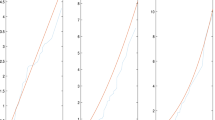Abstract
This paper considers clustered doubly-censored data that occur when there exist several correlated survival times of interest and only doubly censored data are available for each survival time. In this situation, one approach is to model the marginal distribution of failure times using semiparametric linear transformation models while leaving the dependence structure completely arbitrary. We demonstrate that the approach of Cai et al. (Biometrika 87:867–878, 2000) can be extended to clustered doubly censored data. We propose two estimators by using two different estimated censoring weights. A simulation study is conducted to investigate the proposed estimators.
Similar content being viewed by others
References
Andersen PK, Borgan O, Gill RD, Keiding N (1993) Statistical models based on counting processes. Springer, New York
Bennett S (1983) Analysis of survival data by the proportional odds model. Stat Med 2:273–277
Cai T, Wei LJ, Wicox M (2000) Semiparametric regression analysis for clustered failure time data. Biometrika 87:867–878
Cai T, Cheng SC, Wei LJ (2002) Semiparametric mixed-effect models for clustered failure time data. J Am Stat Assoc 97:514–522
Cai T, Cheng S (2004) Semiparametric regression analysis for doubly censored data. Biometrika 91:277–290
Chang MN, Yang GL (1987) Strong consistency of a nonparametric estimator of the survival function with doubly censored data. Ann Stat 15:1536–1547
Chang MN (1990) Weak convergence of a self-consistent estimator for the survival function with doubly censored data. Ann Stat 18:391–404
Chen K, Jin Z, Ying Z (2002) Semiparametric analysis of transformation models with censored data. Biometrika 89:659–668
Cheng SC, Wei LJ, Ying Z (1995) Analysis of transformation models with censored data. Biometrika 82:835–845
Cheng SC, Wei LJ, Ying Z (1997) Prediction of survival probabilities with semi-parametric transformation model. J Am Stat Assoc 92:227–235
Cox D (1972) Regression models and life tables (with discussion). J R Stat Soc B 34:187–220
Dabrowska DM, Doksum KA (1988) Partial likelihood in transformation models with censored data. Scand J Stat 15:1–23
Gu MG, Zhang CH (1993) Asymptotic properties of self-consistent estimators based on doubly censored data. Ann Stat 21:611–624
Huster WJ, Brookmeyer R, Self S (1989) Modelling paired survival data with covariates. Biometrics 45:145–156
Kaplan E, Meier P (1958) Nonparametric estimation from incomplete observation. J Am Stat Assoc 53:457–481
Murphy SA, Rossini AJ, van der Vaart AW (1997) Maximum likelihood estimation in the proportional odds model. J Am Stat Assoc 92:968–976
Mykland PA, Ren J (1996) Algorithms for computing self-consistent and maximum likelihood estimators with doubly censored data. Ann Stat 24:1740–1764
Scharfstein DO, Tsiatis AA, Gilbert P (1998) Semiparametric efficient estimation in the generalized odds-rate class of regression model for right-censored time to event data. Lifetime Data Anal 4:355–391
Shen P-S (2009) An inverse-probability-weighted approach to the estimation of distribution function with doubly censored data. Stat Probab Lett 79:1269–1276
Shen P-S (2011) Semiparametric analysis of transformation models with doubly censored data. J Appl Stat 38:675–682
Shen P-S (2012) Semiparametric mixed-effect models for clustered doubly censored data. J Appl Stat 39:1881–1892
Tsai WY, Crowley J (1985) A large sample study of generalized maximum likelihood estimators from incomplete data via self-consistency. Ann Stat 13:1317–1334
Subramanian S (2007) Median regression analysis from data with left and right censored observations. Stat Methos 4:121–131
Yang S, Prentice R (1999) Semiparametric inference in the proportional odds regression model. J Am Stat Assoc 92:968–976
Zeng D, Lin DY (2007) Maximum likelihood estimation in semiparametric regression model with censored data. J R Stat Soc B 69:507–564
Zeng D, Lin DY, Lin X (2008) Semiparametirc transformation modes with random effects for clustered data. Stat Sinica 18:355–377
Acknowledgments
The author would like to thank the associate editor and referees for their helpful and valuable comments and suggestions.
Author information
Authors and Affiliations
Corresponding author
Rights and permissions
About this article
Cite this article
Shen, Ps. Semiparametric regression analysis for clustered doubly-censored data. Comput Stat 29, 813–828 (2014). https://doi.org/10.1007/s00180-013-0462-1
Received:
Accepted:
Published:
Issue Date:
DOI: https://doi.org/10.1007/s00180-013-0462-1




